MARIANI’S
Virtual
Gourmet
May 27,
2018
NEWSLETTER
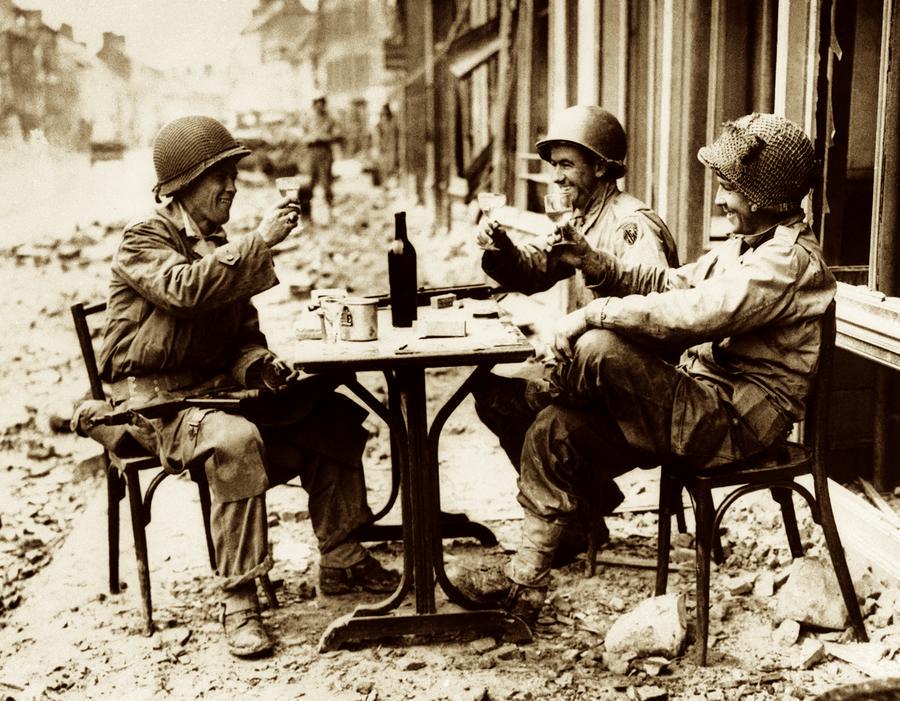
HONOR MEMORIAL DAY
❖❖❖
IN THIS ISSUE
NORTHERN CALIFORNIA EATS
By John Mariani
NEW YORK CORNER
BARBETTA
By John Mariani
NOTES FROM THE WINE CELLAR
WHAT I'M DRINKING NOW
By John Mariani
❖❖❖
NORTHERN CALIFORNIA EATS
By John Mariani
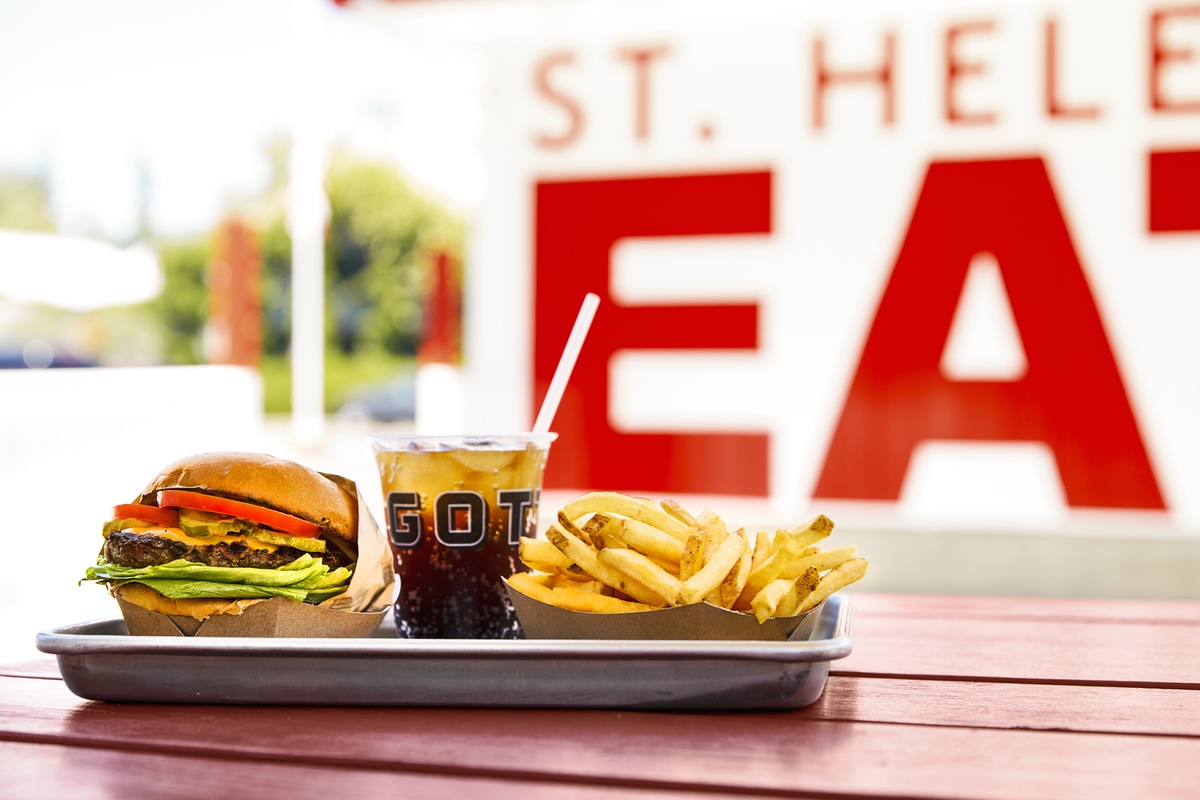
Gott's Roadside, St. Helena, CA
By international standards San Francisco is a very young city, especially since it was destroyed back in 1906 by an earthquake. But it's got history on its side and in its restaurants. Napa Valley, on the other hand, has a much younger gastro-history, when back in 1988 Mustards Grill set a Northern California style and standard for roadside restaurants. Here are some enduringly good places to eat.
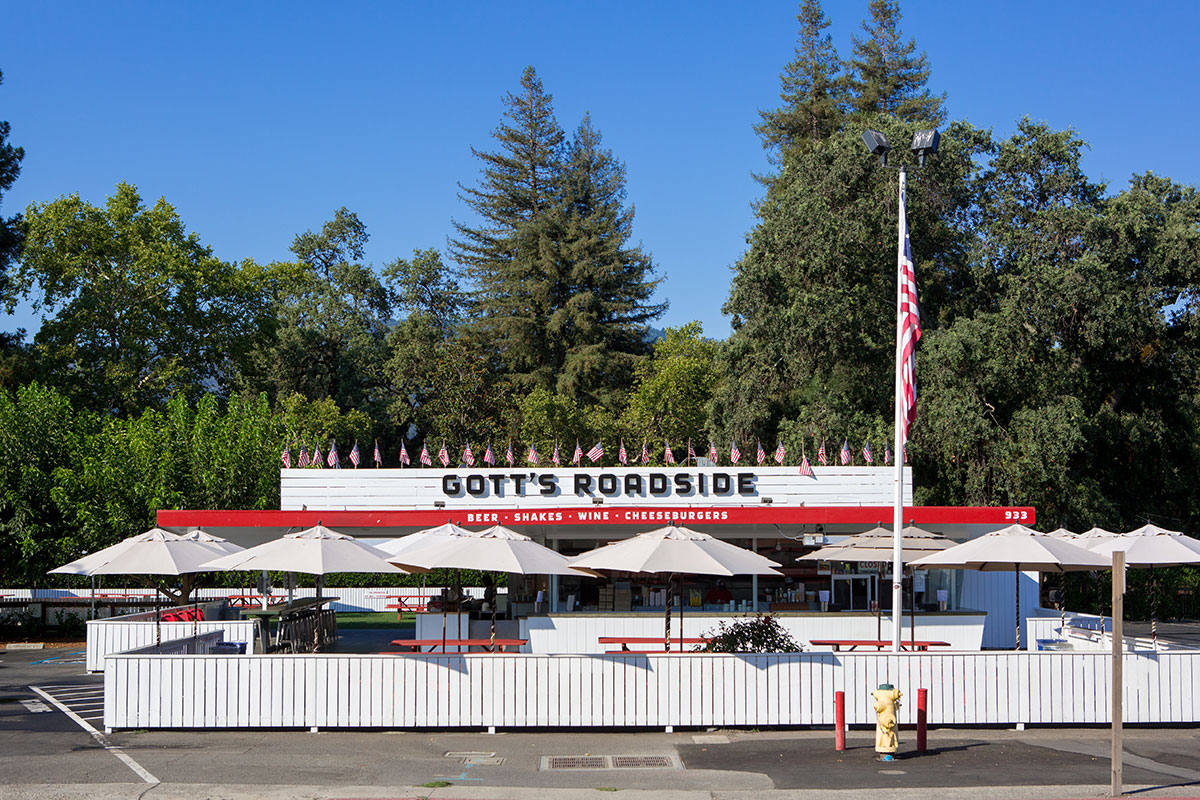 GOTT’S
ROADSIDE
GOTT’S
ROADSIDE
933
Main Street
St.
Helena
707-963-3486
I’m
asked all the time if, dining out as I
do, I ever eat a hamburger. The question
is naïve at best, for the obvious answer is, “Of
course I eat hamburgers, but
only really good ones.” I do not eat the junk
food they serve at McDonald’s,
Wendy’s and the rest, and I do not order $50
burgers topped with foie gras and
truffles at high-end restaurants like Daniel
Boulud’s db Bistro Moderne in New
York.
Burger
culture in America has become so extravagant
that every menu—even seafood
restaurants, Italian restaurants and French
bistros—have to have one on the
menu, usually made with beef better suited to a
T-bone or beef tartare. When I
want a burger I want one that tastes like what I
actually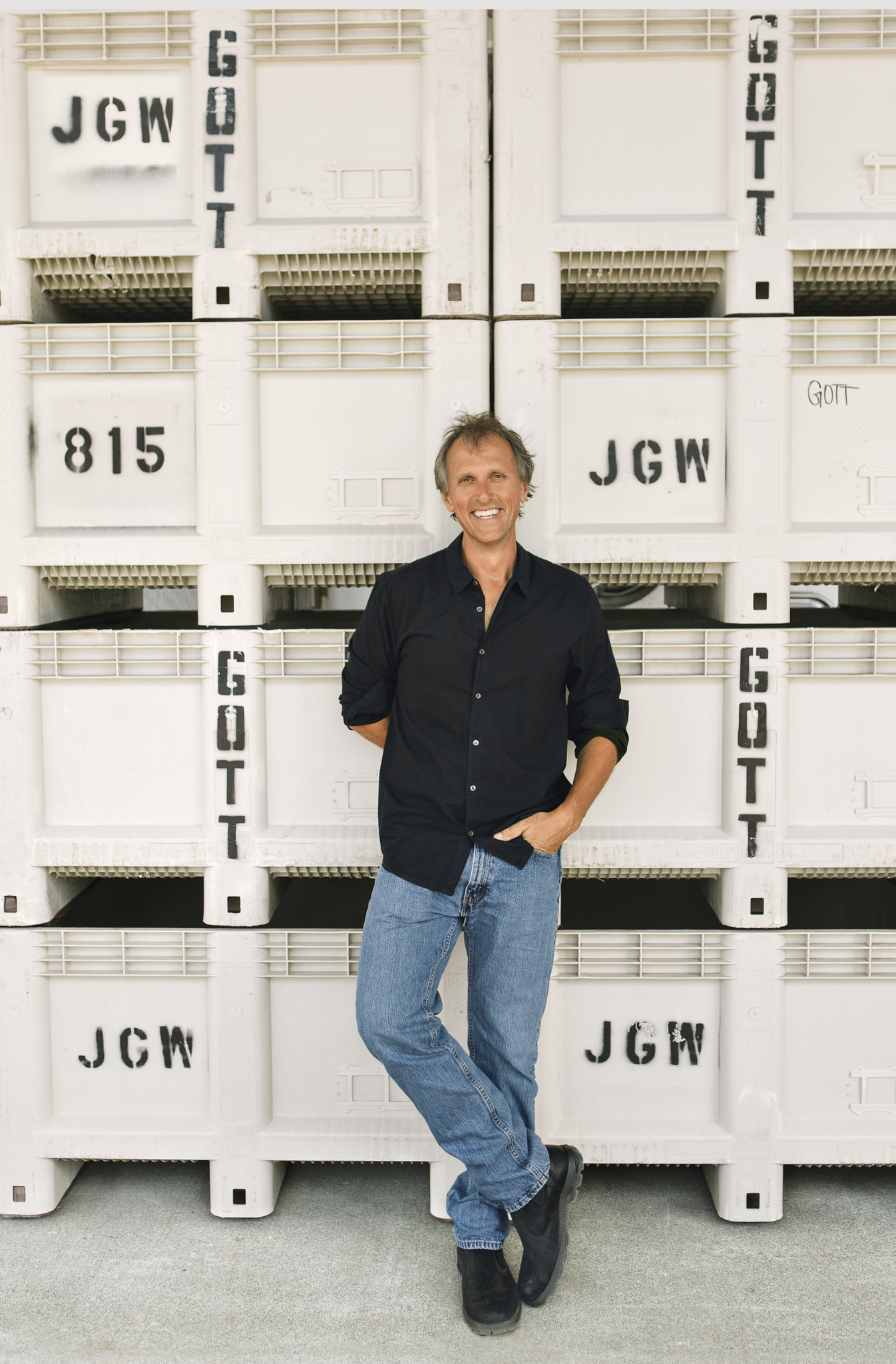 crave in a burger: a
good grind of meat, a good bun, careful cooking
made perfect by repetition, and
a few condiments or additions, like onions or
tomato that enhance rather than
dominate the favorite American sandwich.
crave in a burger: a
good grind of meat, a good bun, careful cooking
made perfect by repetition, and
a few condiments or additions, like onions or
tomato that enhance rather than
dominate the favorite American sandwich.
This
is what I get at Gott’s, a small chain in
California whose original restaurant
was opened by brothers Joel and Duncan Gott in
1999 in St. Helena in the Napa
Valley wine country. (There are now branches in
Napa, San Francisco, SFO
International Airport, Palo Alto, Walnut Creek
and Marin.) It
had been a place called Taylor's Refresher
since 1943, and the Gotts kept the old sign. Back
then, hamburger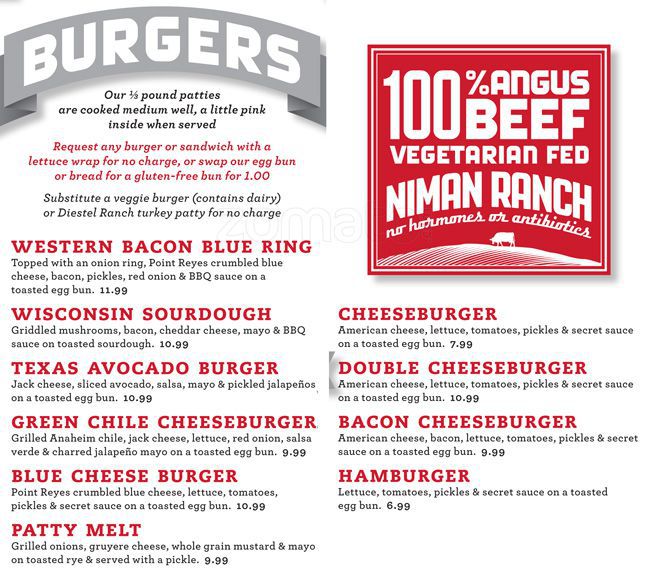 menus
had not
taken over the foodie media ravenous for
extravagant concoctions on a bun. What
the Gott brothers did do was to use the best
locally sourced ingredients and
purveyors, such as Niman Ranch beef, Zoe’s
bacon, Panorama Bakery breads, and
Osprey Seafood.
In addition, Gott’s
stocks a list of California-centric wines and
beers unlikely to be found at any
other burger chain.
menus
had not
taken over the foodie media ravenous for
extravagant concoctions on a bun. What
the Gott brothers did do was to use the best
locally sourced ingredients and
purveyors, such as Niman Ranch beef, Zoe’s
bacon, Panorama Bakery breads, and
Osprey Seafood.
In addition, Gott’s
stocks a list of California-centric wines and
beers unlikely to be found at any
other burger chain.
The
burger menu includes a dozen variations,
including the California Burger with a
fried egg, Zoe's bacon, and balsamic onions,
which to me is a great American
sandwich. The fries are excellent, the soft
serve ice cream and shakes
irresistible, and the price is right: $7.99 to
$12.99.
Oh,
they also have added a bunch of trendy items
over the years, like a kale salad
($7.99) and ahi poke tacos ($14.99), but it’s
impossible for me to go to Gott’s
and order such things. I want to
pull into the parking lot, get on line, wait
longingly for my order, sit
outside on a bench under a white umbrella and
watch the cars go by on Main
Street, just before they slow down to get into
the town of St. Helena.
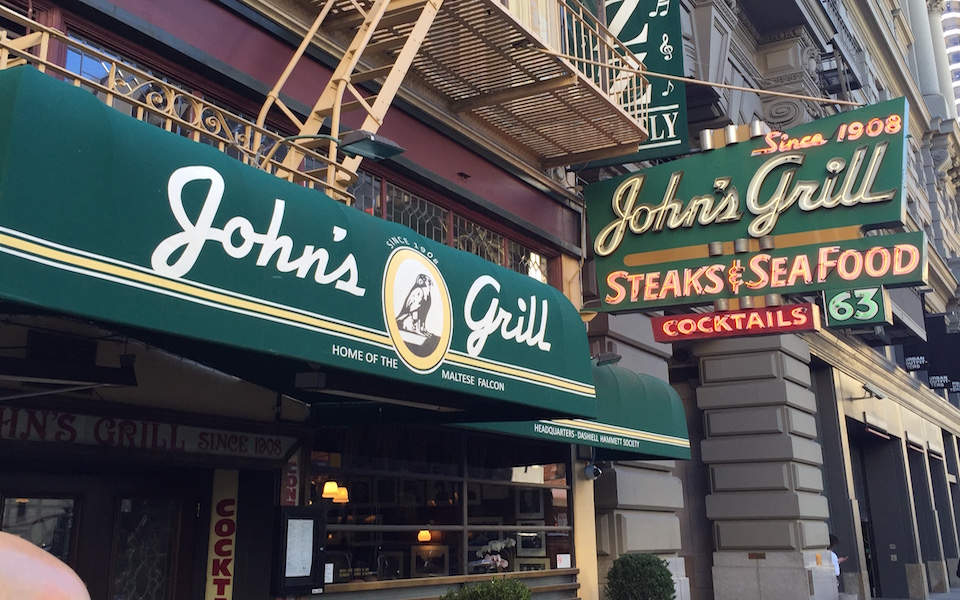 JOHN’S
GRILL
JOHN’S
GRILL
63
Ellis Street
415-986-0069
Enduring
now
for 100 years, John’s Grill almost never
happened because the 1906 San
Francisco earthquake delayed its opening for a
while. When it did open it was
the first restaurant to do so in the devastated
city, and in all that time
hasn’t changed very much. The wooden walls  are original, the style of tables
and chairs the same and the tradition of hanging
photos of celebrated guests
has been maintained right up to the present. The
tablecloths are still white and starched;
there's a good breadbasket with plenty of
butter; there's even a flower in a vase on the
table. John’s still serves about 500
diners every day.
are original, the style of tables
and chairs the same and the tradition of hanging
photos of celebrated guests
has been maintained right up to the present. The
tablecloths are still white and starched;
there's a good breadbasket with plenty of
butter; there's even a flower in a vase on the
table. John’s still serves about 500
diners every day.
You’ll
see it from up the block for its neon sign is as
totemic as any in San
Francisco, and the three-story building is
unlikely to budge from its location off
Market Street because owner John Konstin’s
father, Gus, bought the property
forty years ago. One of the few changes that
reflect a less genteel trend is
the dropping of a gentleman’s dress code, after
Silicon Valley billionaires
started traipsing in in t-shirts and jeans.
 No
one would deny that a good deal of John’s appeal
is that it was mentioned in a
single paragraph as the restaurant where
Dashiell Hammett’s detective Sam Spade
had his dinner in The Maltese Falcon (above)—lamb
chops, a baked potato and sliced
tomatoes (left)—a
combo still available on the menu ($36.95).
Indeed, the Konstins
have long had a glass-enclosed black falcon
exhibited on the second floor,
along with more of the novel’s memorabilia. Over
the years everyone from Ronald
Reagan to Hillary Clinton, Brian Wilson to
Johnny Depp, and Julia Child to
Truman Capote have eaten at John’s.
No
one would deny that a good deal of John’s appeal
is that it was mentioned in a
single paragraph as the restaurant where
Dashiell Hammett’s detective Sam Spade
had his dinner in The Maltese Falcon (above)—lamb
chops, a baked potato and sliced
tomatoes (left)—a
combo still available on the menu ($36.95).
Indeed, the Konstins
have long had a glass-enclosed black falcon
exhibited on the second floor,
along with more of the novel’s memorabilia. Over
the years everyone from Ronald
Reagan to Hillary Clinton, Brian Wilson to
Johnny Depp, and Julia Child to
Truman Capote have eaten at John’s.
I’ve
been a fan of John’s for a long time, and while
I know that the Konstin family
buys first-rate meats, seafood and vegetables,
there’s little I’ve eaten there
that I’d rave about. It’s just good, solid
American fare, competently prepared
and generous in its portions. You
get half a dozen of those lamb chops, and there
must be a half pound of Bay
shrimp with a Louis dressing on the plate
($16.95). I do recommend the petrale
sole (below)
with a shower of buttered
almonds and butter 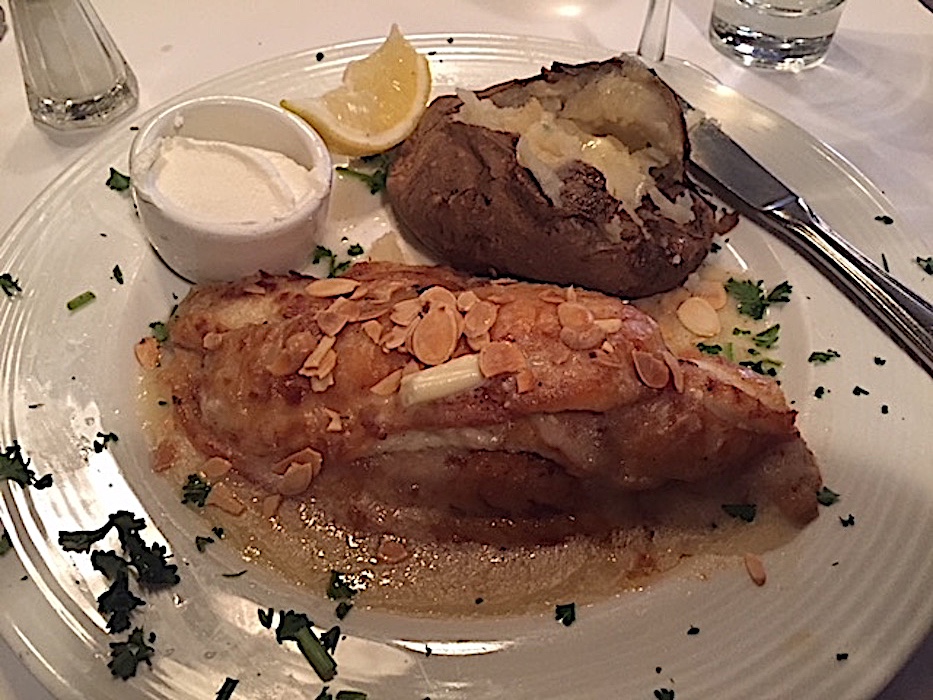 sauce surrounded by
mashed potatoes ($27.95), and the
Dungeness crab cocktail ($19.95) is sweet and
delicious.
The red snapper is topped with a mound
of shrimp, crabmeat and mushrooms and lavished
with a lemon cream ($34.95). You
can safely skip dessert. (Prices, by the way,
are quite a bit less for the same
items at lunchtime.)
sauce surrounded by
mashed potatoes ($27.95), and the
Dungeness crab cocktail ($19.95) is sweet and
delicious.
The red snapper is topped with a mound
of shrimp, crabmeat and mushrooms and lavished
with a lemon cream ($34.95). You
can safely skip dessert. (Prices, by the way,
are quite a bit less for the same
items at lunchtime.)
The
veteran bartenders at John’s take their craft
very seriously and make a number
of special cocktails like Spade’s Manhattan
($14) and Bogie’s Old Fashioned
($15). The wine list is not among the
comprehensive lists found elsewhere in
the city but it is solidly selected and focused
on very good California labels.
I
guess I go to John’s mostly for the history, the
jaunty mood of the place, and
those dishes I crave, and I’m just as happy
sitting alone watching who’s coming
and going, taking my time to nurse my cocktail
and then finish off dinner with
a nightcap.
I’ll hear the clang of
the cable car outside and I’ll just forget what
year it is.
ONE
MARKET
1
Market Street
415-777-5577
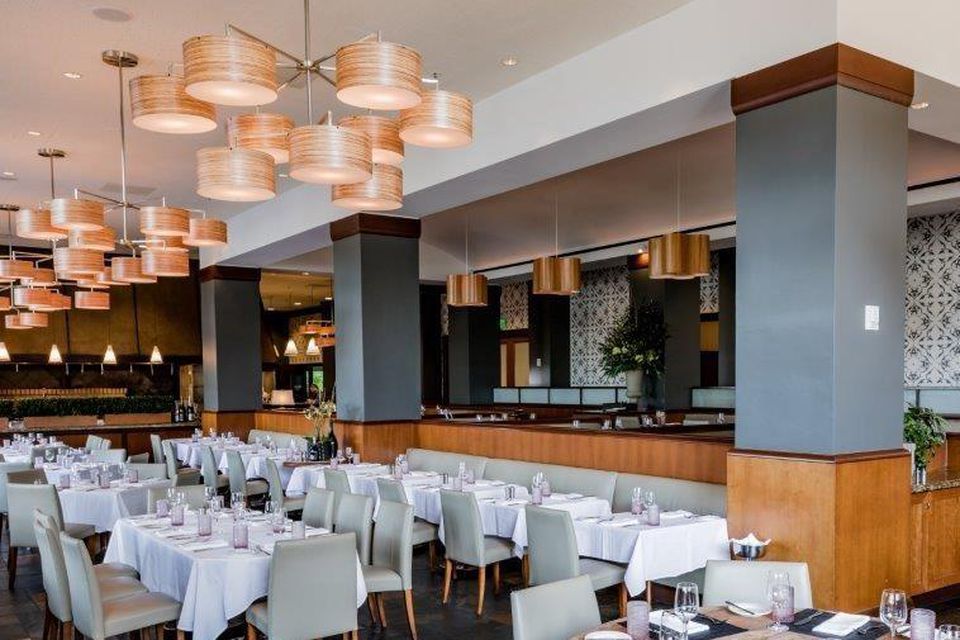 Few
restaurants ever get to celebrate their
25th anniversary, especially when it
started out in a derelict corner of a
city.
Few
restaurants ever get to celebrate their
25th anniversary, especially when it
started out in a derelict corner of a
city.
“There was a soup kitchen
across the street and
the restoration of the old Ferry Building was
years away,” says owner Michael
Dellar (below on
the right), who, with general manager
Larry Bouchard, opened One Market Restaurant
in San Francisco in 1993 on Market Street.
The grotesque Embarcadero
Freeway had been torn
down after the 1989 earthquake, and grindingly
slow construction of the city’s
BART rail system ruined Market Street’s retail
business. Street crime soared.
Even as late as 2009 Streetsblog SF described the
area as “congested,
hazardous, and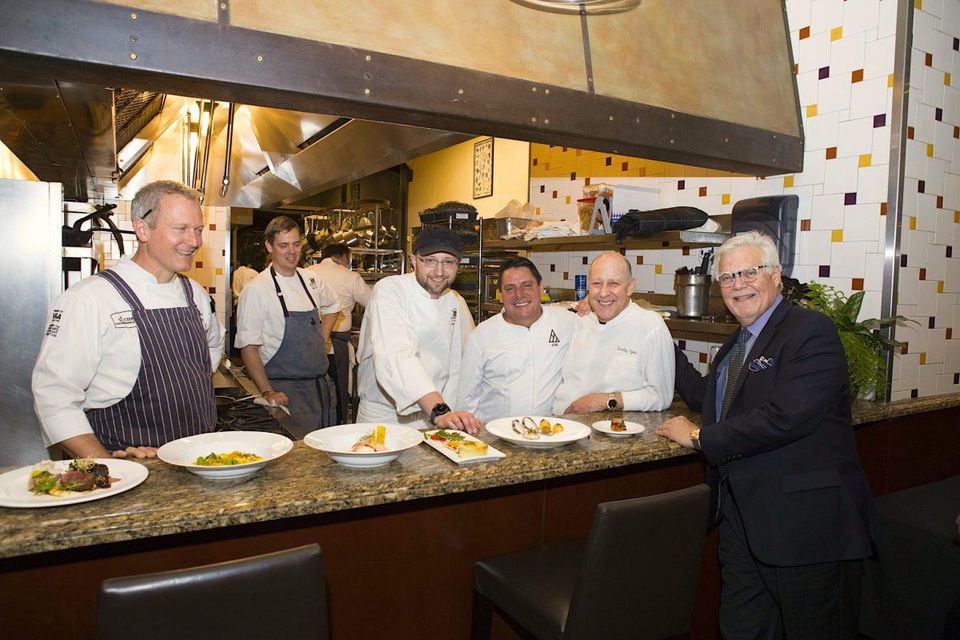 in poor repair.”
in poor repair.”
“When we opened the restaurant
people asked us
if we’d be here in twenty-five years,” says
Dellar, “and I told them, `Of
course we will; we signed a 30-year lease!” He
paused, then added, “At a dollar
per square foot.”
An affordable thirty-year lease
on a
less-than-prime property allowed the partners to
gamble on a neighborhood
largely devoid of any restaurants, much less a
grand American brasserie with an
open kitchen and rotisserie, vast wine cellar and
its own meat locker for
aging.
Now,
twenty-five years later, One Market has
served three million diners, which Dellar notes is
“three times the population
of San Francisco.” And the blossoming of the
area—now nicknamed Soma for South
of Market—was kick started by the restaurant and
the restoration of the Ferry
Building into a marketplace by bringing a vitality
and tourists to the block.
If not ideally situated, One
Market was among
the first of a new generation of San Francisco
restaurants that followed
trailblazers like Alice Waters’s Chez Panisse (in
Berkeley), 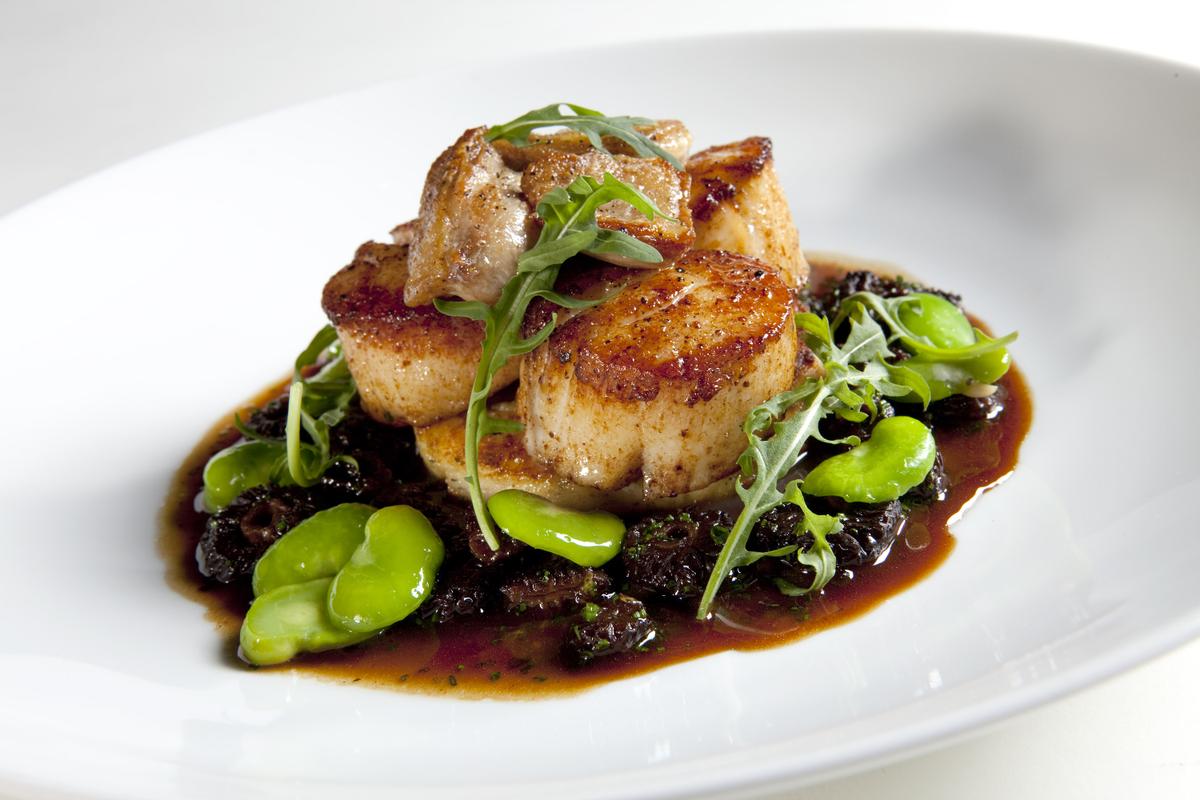 Jeremiah
Tower’s
Stars, and Wolfgang Puck’s Postrio. By the
mid-‘80s San Francisco had changed
from being a tourist dining town with a slew of
brocade-wallpapered continental
restaurants like Ernie’s and The Blue Fox to a
crucible of so-called “New
California Cuisine” that stressed the freshest
local ingredients and the best
wines coming out of the nearby Napa and Sonoma
valleys. Dellar’s wife, Leslye,
still does the restaurant’s flower arrangements.
Jeremiah
Tower’s
Stars, and Wolfgang Puck’s Postrio. By the
mid-‘80s San Francisco had changed
from being a tourist dining town with a slew of
brocade-wallpapered continental
restaurants like Ernie’s and The Blue Fox to a
crucible of so-called “New
California Cuisine” that stressed the freshest
local ingredients and the best
wines coming out of the nearby Napa and Sonoma
valleys. Dellar’s wife, Leslye,
still does the restaurant’s flower arrangements.
Dellar first joined forces with
young chef
Bradley Ogden at the acclaimed Lark Creek in Marin
County. In 1993, they
returned to San Francisco to take on the biggest
restaurant project seen in the
city in many years. In 1997 chef George
Morrone, whose restaurant
Aqua pioneered a new style of seafood cuisine in
the city, took over One
Market’s kitchens, followed in 2001 by Adrian
Hoffman, and in 2004 by the
current resident, Mark Dommen, who earned One
Market its first Michelin star (above).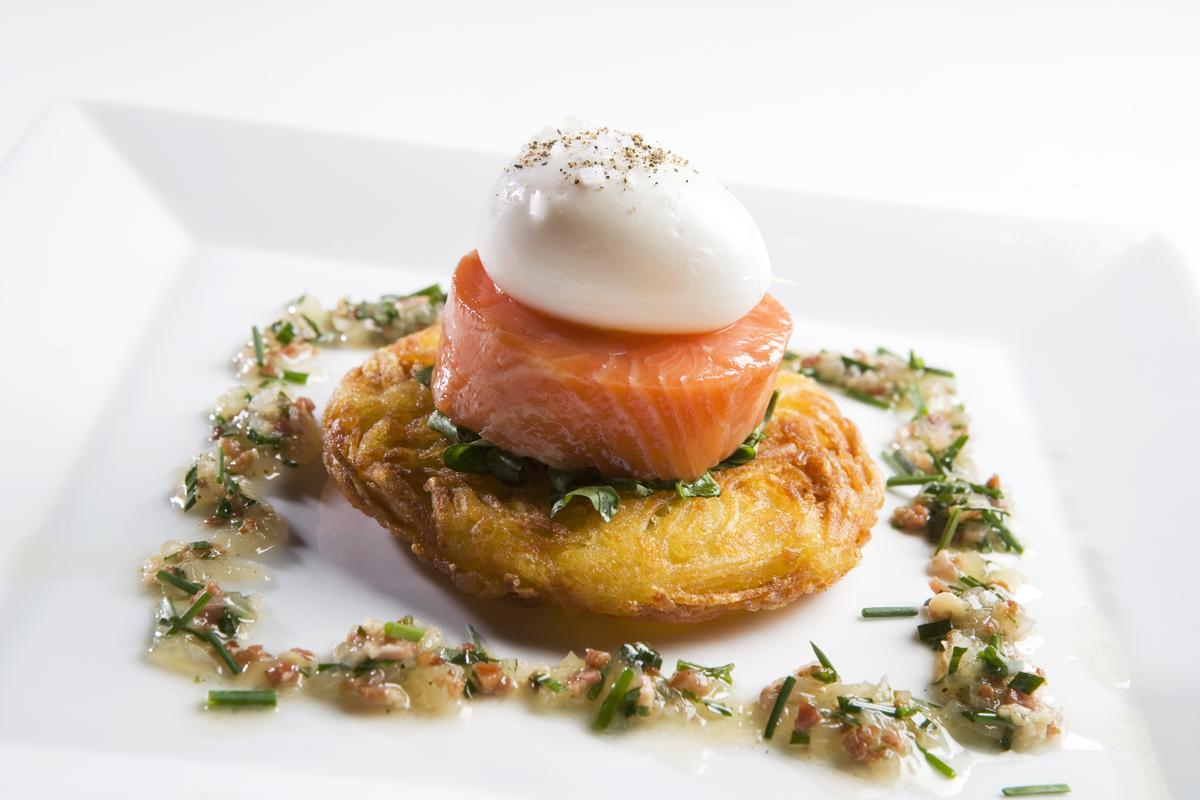
To
celebrate One Market’s silver anniversary
the restaurant threw a charity gala in January for
invited guests and included
a performance by San Francisco’s iconic jazz
singer Paula West—-an original
employee at the restaurant. For the event Ogden,
Morrone and Hoffman joined Dommen
for a five-course meal of dishes they made famous
over the years: Ogden’s Point
Reyes blue cheese soufflé with a blood orange
gastrique; Morrone’s
Pommery-poached lobster with vanilla, jalapeño
butter and saffron potato;
Hoffman’s tortelli pasta of veal breast with
bottarga and pine nuts; and
Dommen’s prime New York steak with beef cheeks,
marrow, smoked mashed potatoes
and truffles. Pastry chef Patti Dellamonica-Bauler
contributed a chocolate
gâteau with chocolate-caramel sorbet.
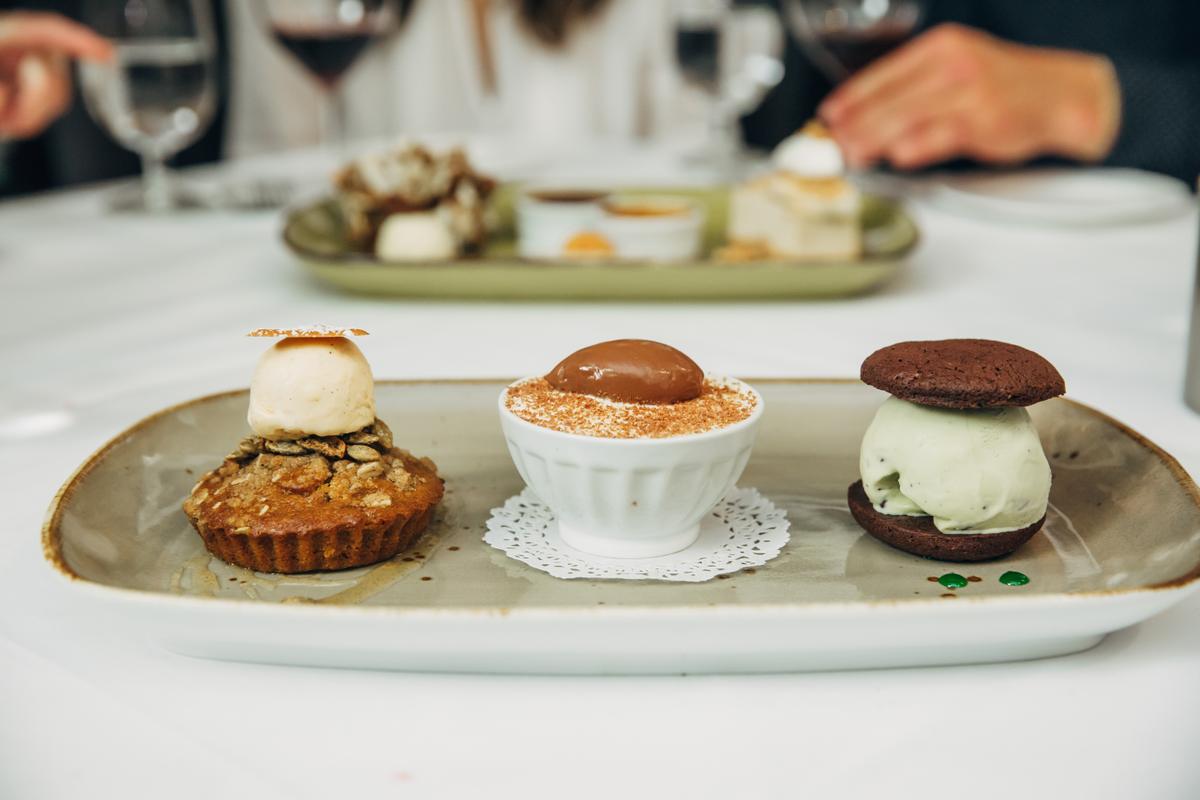 California
wines were poured by Sommelier and
Wine Director Tonya Pitts.
California
wines were poured by Sommelier and
Wine Director Tonya Pitts.
In speaking to his guests
Dellar stressed that
from the beginning the straightforward style of
One Market’s food would always
be maintained—Ogden’s Caesar salad is still on the
menu—whoever the chef may
be, and that he had little interest in trendy
foods, instead focusing on West
Coast seafood like Alaskan halibut, Dungeness crab
and Pacific swordfish and
not complicating the dishes, many cooked over an
open wood fire.
One Market refined that idea
and has stuck with
it. Persistence seems to have paid off. While most
of the first generation of
New California restaurants have closed—Stars,
Postrio, Masa’s, Santa Fe Bar and
Grill, and others—after their fashion wore thin,
One Market thrives on keeping
to basics it established a quarter century ago in
a location whose current
gentrification started when One Market turned its
lights onto the street.
❖❖❖
By John Mariani
Food photos by Wallace Jordan
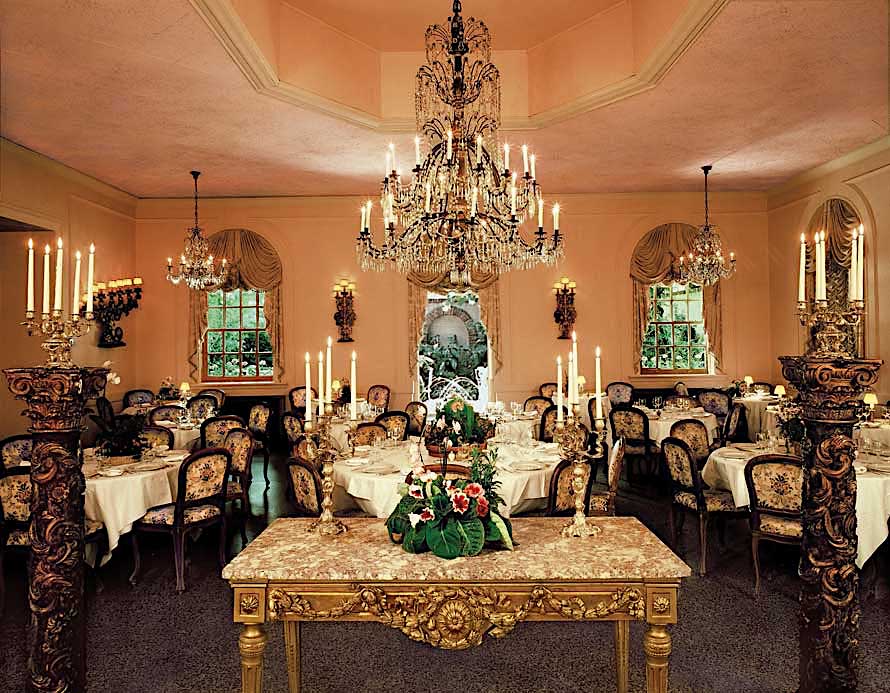
The
story of Barbetta has been told ever
since its inception in 1906 in its
original location on West 39th Street and ever
since it moved to West 46th
Street in the heart of the Theater District. The founder, Sebastiano
Maioglio, whose brother Vincenzo’s little
beard gave Barbetta its name, and his wife, Piera,
ran it for decades, drawing
every personage of the art and music world from
Puccini and Caruso to Mick
Jagger and Madonna to its rambling townhouses for
Piedmontese cuisine one could
find nowhere else in the city.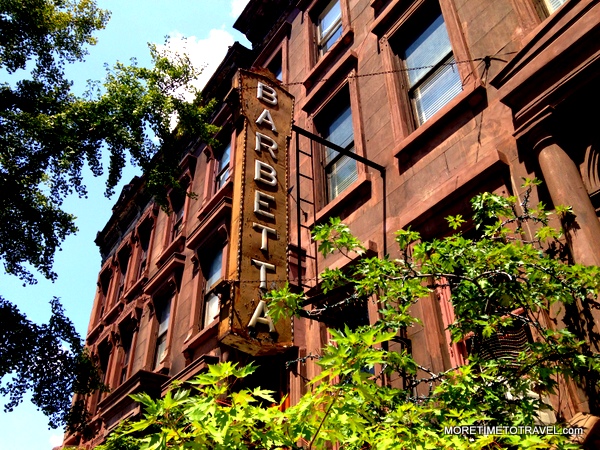
With the
passing of her parents, the continuance and legacy
of Barbetta fell on the
shoulders of their daughter, Laura, who had been
groomed for a career in the
arts but suddenly found herself carrying on in
their absence. Laura threw herself
into saving Barbetta by bringing to it a unique
Italian antique décor and a
gorgeous outdoor garden. She was the first to
bring Piedmontese wines like
Barolo, Barbaresco and Grignolino to the U.S. as
well as the first white
truffles of Alba (1962) sniffed out by the
Maioglios’ own truffle hounds! Barbetta
was also one of the first
restaurants to discourage smoking in the dining
room by replacing matchbooks
with mints on the table. 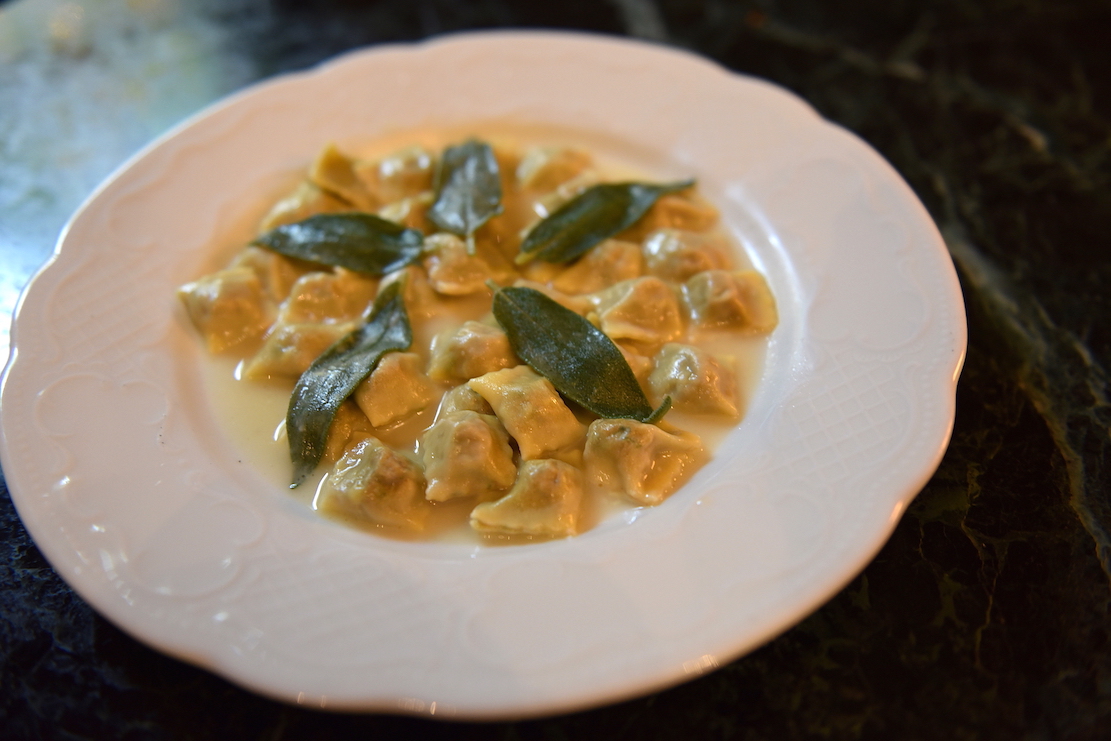
Who
takes over Barbetta next is very
much open to question. Laura’s husband,
Günter Blobel, who won the Nobel Prize for
Medicine in 1999, passed away
recently and now Laura is by herself, with no
children to undertake the
restaurant’s future. Not that Laura Maioglio has
lost any of her legendary
spunk and standards, hovering over tables with a
spoon out of place, asking why
a guest ordered a tomato dish with Champagne and
recalling old memories with
friends who have dined there for fifty years.
Barbetta’s
menu is long, with dishes with the dates they were
added, like a beautiful
quail’s nest of fonduta cheese in 1962 ($12).
Robiola cheese, rarely seen in
the city, is wrapped with grilled zucchini ($11).
The salmon is house smoked
($12), and there is an antipasti sampler I’d
recommend for the table.
 As in
most Italian ristoranti,
the pastas
are the showpieces, and the Piedmontese
specialties are definitely the way to
go. Tajarine
(tagliolini) are served with a lush,
oven-roasted tomato sauce
($11), and agnolotti
(above)
with ricotta are
hand made, of course ($12).
Risotto is the pride of Piedmont, so
Barbetta offers several variants
(each $12), including with porcini mushrooms,
roasted red beets, with herbs,
and with Gorgonzola and Camembert, and Rose
Champagne. The happy news is you can
sample three of them together for $23. By the way,
the pasta prices are for
second-course portions; for a main course portion
figure $21 or a bit more.
As in
most Italian ristoranti,
the pastas
are the showpieces, and the Piedmontese
specialties are definitely the way to
go. Tajarine
(tagliolini) are served with a lush,
oven-roasted tomato sauce
($11), and agnolotti
(above)
with ricotta are
hand made, of course ($12).
Risotto is the pride of Piedmont, so
Barbetta offers several variants
(each $12), including with porcini mushrooms,
roasted red beets, with herbs,
and with Gorgonzola and Camembert, and Rose
Champagne. The happy news is you can
sample three of them together for $23. By the way,
the pasta prices are for
second-course portions; for a main course portion
figure $21 or a bit more.
Old
fashioned but very good is a main course of jumbo
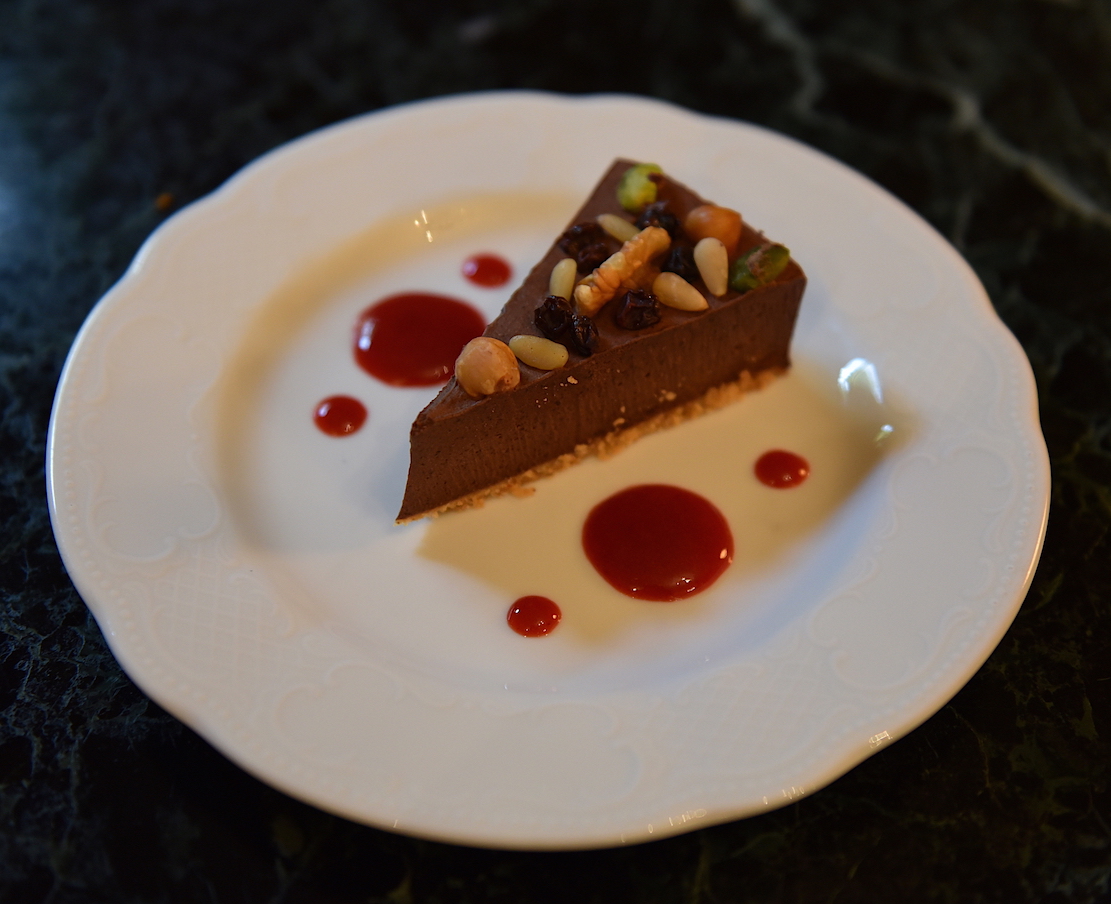 lump crabmeat sautéed in
Sherry and served with wild rice ($27), and the
roasted rabbit alla
Piemontese is done in a delicious
white wine sauce ($26). A break
from
lump crabmeat sautéed in
Sherry and served with wild rice ($27), and the
roasted rabbit alla
Piemontese is done in a delicious
white wine sauce ($26). A break
from 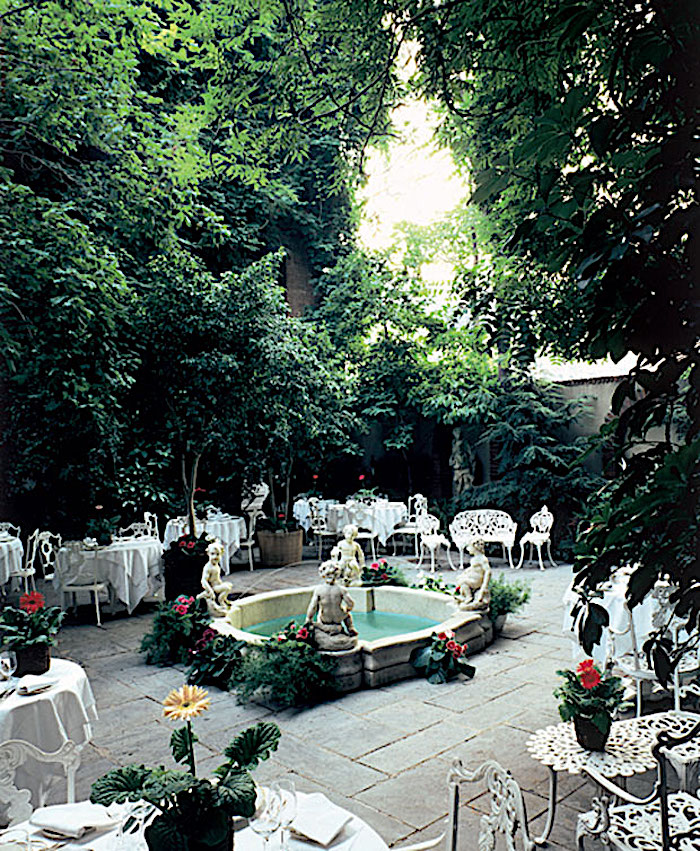 Piedmont is the
Venetian-style calf’s liver with onions ($26)
while roast
chicken comes in a pomegranate sauce with
chive-laced mashed potatoes ($22).
Piedmont is the
Venetian-style calf’s liver with onions ($26)
while roast
chicken comes in a pomegranate sauce with
chive-laced mashed potatoes ($22).
There
are many good reasons to try the desserts, for
some are unique to Barbetta,
including monte
bianco, a chestnut
cream topped with snowy whipped cream made to look
like Mont Blanc in
Switzerland. Also very good is the Gianduja
chocolate cake (right)
and the pears baked
in red wine, once a standard of Italian
restaurants now rarely seen.
I should
mention that, despite the beauty of the décor, Old
World service, grand wine
cellar and superb cuisine, prices at Barbetta are
considerably below other
Italian restaurants of its ilk, such as Ai Fiori,
Del Posto, Babbo or Marea.
Right now the
exquisite and quiet garden is open for dining,
and one would search fruitlessly for a more
romantic place to dine well in the Theater
District,
Barbetta
serves lunch and dinner
daily. Pre-theater dinner $58.
By John Mariani
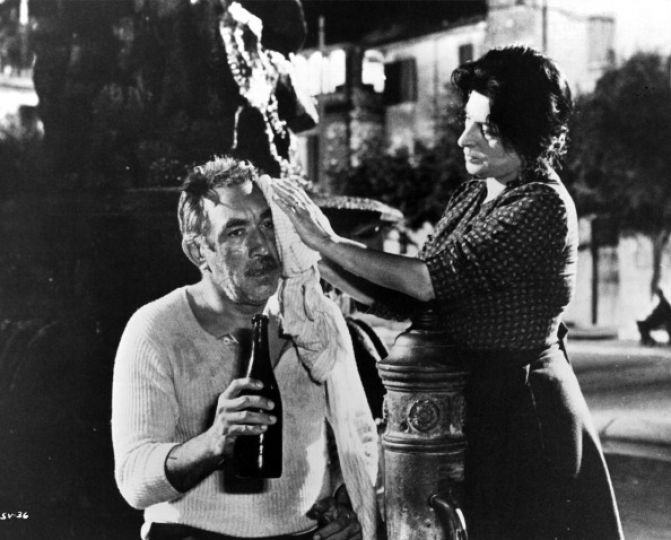
Summer is
struggling to arrive here on the East
Coast, which means cleaning the grill for
outdoor dining and considering wines that
will go well with the season's food.
Here's what I've chosen thus far.
 JOEL GOTT PINOT
NOIR 2016 ($18)— Joel
Gott, beginning in 1996, has a catholic
approach to making wines through
blending of grapes from California, Oregon
and Washington, though largely from
Santa Barbara, which enjoys cooling breezes
from the Gabilan Range and Santa
Lucia Mountains. This means you’re
not getting one of those hot, high alcohol
western Pinot Noirs; instead the
acidity keeps it of light to medium body
with nice cherry flavors, at a fine
13.9% alcohol. Being aged mostly in
stainless steel helps maintain its
freshness before going into new and
2-to-3-year-old French oak barrels to tamp
down the tannins.
JOEL GOTT PINOT
NOIR 2016 ($18)— Joel
Gott, beginning in 1996, has a catholic
approach to making wines through
blending of grapes from California, Oregon
and Washington, though largely from
Santa Barbara, which enjoys cooling breezes
from the Gabilan Range and Santa
Lucia Mountains. This means you’re
not getting one of those hot, high alcohol
western Pinot Noirs; instead the
acidity keeps it of light to medium body
with nice cherry flavors, at a fine
13.9% alcohol. Being aged mostly in
stainless steel helps maintain its
freshness before going into new and
2-to-3-year-old French oak barrels to tamp
down the tannins.
POLIZIANO VINO NOBILE DI
MONTEPULCIANO
2014
($28)—A very good price for a
very good example of a Vino Nobile,
made from 85% Prugnolo Gentile along with
out-of-fashion Colorino, Canaiolo and a
touch of softening Merlot. It spends 14 to16 months in
wood, both in large casks and
barriques. The website says this is a wine
to keep for ten to twelve years, but
it’s too good right now to wait around and
hope it gets better.
of a Vino Nobile,
made from 85% Prugnolo Gentile along with
out-of-fashion Colorino, Canaiolo and a
touch of softening Merlot. It spends 14 to16 months in
wood, both in large casks and
barriques. The website says this is a wine
to keep for ten to twelve years, but
it’s too good right now to wait around and
hope it gets better.
LUIGI EINAUDI PODERI IN CANNUBI
BAROLO CANNUBI 2012
($78)—One wine magazine finds this bottling
full of “Leather, underbrush,
earth, iris and woodland berry,” which I
would prefer not to drink. Instead, I
find the excellent expression of the
illustrious Cannubi terroir, 720 feet
above sea level with a southern and
southeastern exposure, gives the grapes a
finesse lacking in warmer terroirs.
This is Barolo as it should be, warm,
satisfying and at a fair price. It
will improve for the next five years, but
it’s eminently drinkable with
pleasure right now.
DOMAINES SCHLUMBERGER PINOT NOIR LES PRINCES ABBES 2014 ($24 )—Anyone looking for a blockbuster Pinot Noir will not find it in Alsatian examples. Rather, this varietal, which for a long time pretty much disappeared from Alsace vineyards, has made a comeback and is showing its own special characteristics that come from the high limestone content of the soil. It is actually better to drink this wine while it’s young, for it has wonderful flowery notes in the bouquet, and it’s ideal for a summer red wine, at only 12.9% alcohol.
GOUGUENHEIM VALLE ESCONDIDO MALBEC
2014
($8-$9)—Yes, you read that right:
eight or nine bucks a bottle for this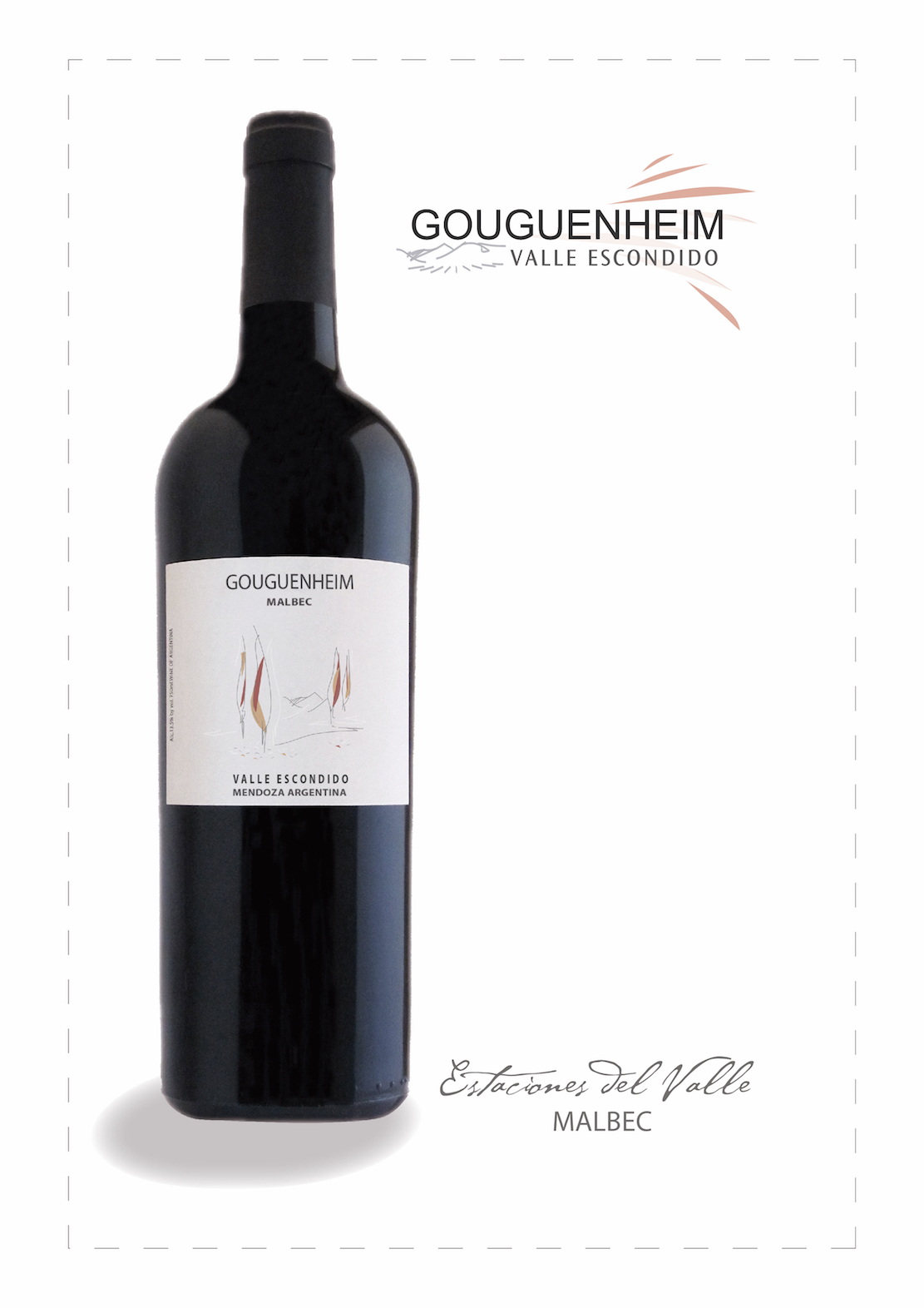 admirable Mendoza Malbec, whose grapes grow
at 3,600 feet in what is basically
a desert climate. Those grapes struggle and
irrigation from the Andes Mountain
waters is allowed. Patricio Gouguenheim took
a brave leap to open his winery in
2002, just when Argentina’s
economy tanked, and he has now built
it up to sell his wines in 15
global markets. You could drink
this—especially at this price—several times
a
month with all sorts of meat dishes.
admirable Mendoza Malbec, whose grapes grow
at 3,600 feet in what is basically
a desert climate. Those grapes struggle and
irrigation from the Andes Mountain
waters is allowed. Patricio Gouguenheim took
a brave leap to open his winery in
2002, just when Argentina’s
economy tanked, and he has now built
it up to sell his wines in 15
global markets. You could drink
this—especially at this price—several times
a
month with all sorts of meat dishes.
MATANZAS CREEK WINERY SAUVIGNON BLANC 2016 ($14.99)—Matanzas Creek in Santa Rosa has been making wine on what was once a dairy farm since 1997 (now under the Jackson Family group), and since 2010 winemaker Marcia Torres Forno has transformed the estate’s production of Sauvignon Blanc through new plantings and harvesting. They now make five different bottlings from the varietal—highly unusual for a California winery—and the result is a creamier, more refreshing example without the cloying punch-like flavors of so many others. I love this with grilled chicken and seafood during the summer, and it’s excellent paired with cheeses.
❖❖❖
 HEEERE'S JOHNNY!
HEEERE'S JOHNNY!
DEPT. OF OXYMORONS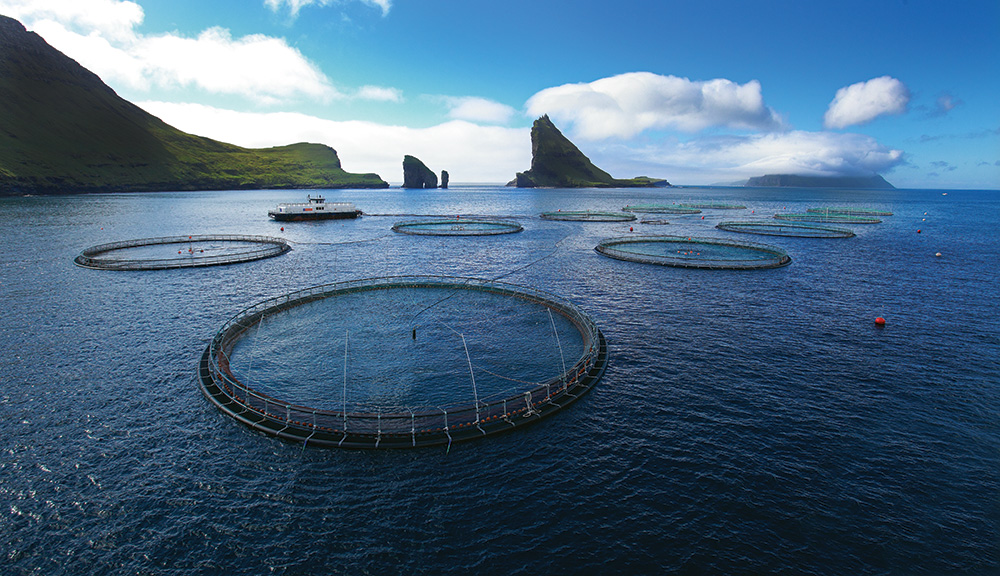
HIDDEN
FJORD SUPERIOR SALMON's website
ad motto is "Raised
in the Wild."
Wine
Column Sponsored by Banfi Vintners
SANGIOVESE
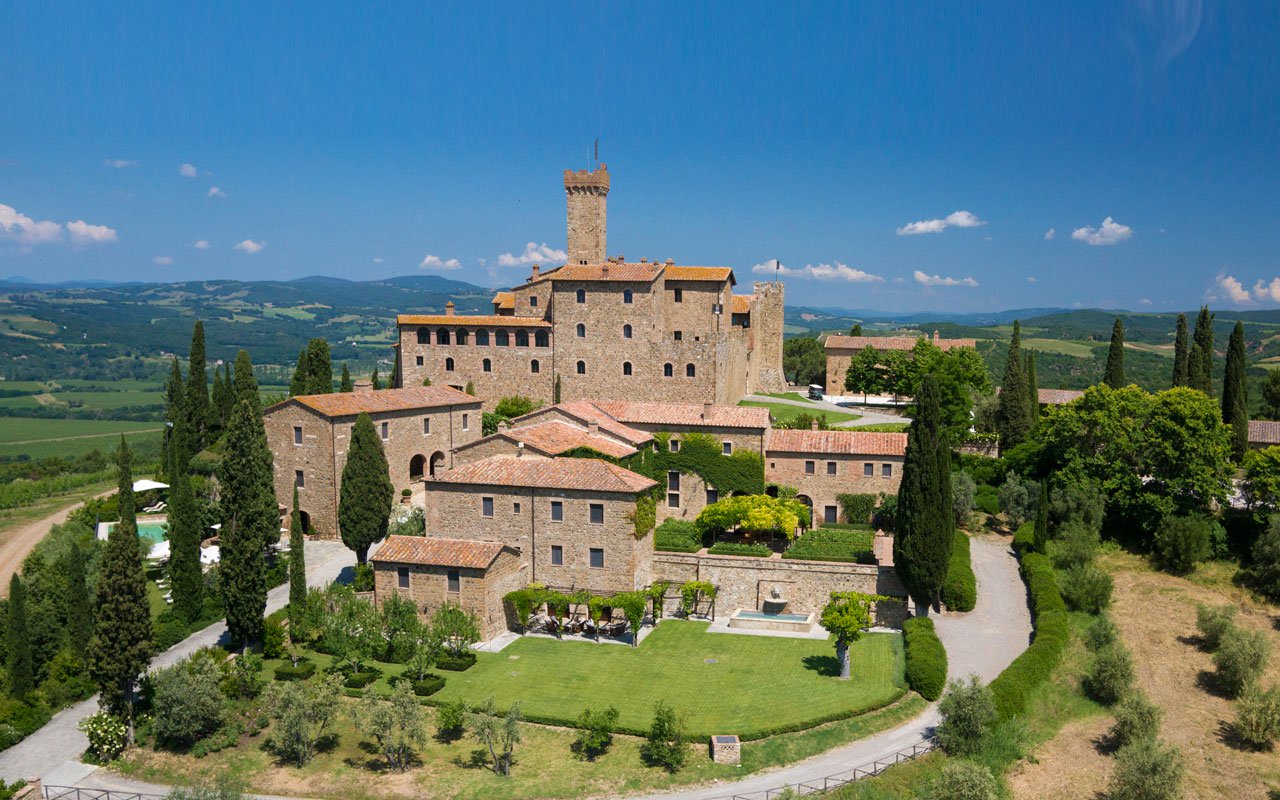 Wine is a joy year-round but
in cooler weather one
grape varietal has really taken center stage in
my daily activities – that most Italian of
grapes, Sangiovese, and its ultimate expression
– Brunello di Montalcino.
Wine is a joy year-round but
in cooler weather one
grape varietal has really taken center stage in
my daily activities – that most Italian of
grapes, Sangiovese, and its ultimate expression
– Brunello di Montalcino.
From mid-September through mid-October,
the Sangiovese grown for our various styles of red
wines are be harvested, culminating with the top
selection for Brunello di Montalcino.
Second, cooler weather here means
it is time to start enjoying more red wines and
especially Sangiovese based wines. That
includes Banfi’s cru of Brunello, Poggio alle Mura,
literally the cream of the crop of our Sangiovese
vineyards. Alongside our Poggio alle Mura Brunello di
Montalcino, this year we introduced two more wines
from the cru Poggio alle Mura – a Rosso di Montalcino
and a Riserva of Brunello. Rosso is sort of like the
younger brother of Brunello, also made from 100%
Sangiovese grapes but usually a selection from younger
vines and the wine is aged only two years compared to
the four required for Brunello. The
Riserva, on the other hand, is an even more selective
harvest of Sangiovese, and ages for an additional year
before release.
What is so special about this cru
Poggio alle Mura?
Well, it is the result our over 30 years of
ongoing research at my family’s vineyard estate,
Castello Banfi.
When we first began planting our vines there in
the late 1970s studies from the University of Bordeaux
indicated which strains of many varietals we should
plant, based on the soil type and microclimate of each
vineyard. But
when it came to the region’s native Sangiovese, there
was only local lore, no scientific research. So we took
it upon ourselves to figure out this vine, and set off
on three decades of incredibly detailed research.
We started
with 600 apparent variations on Sangiovese, because it
is so susceptible to variations in weather and soil,
and narrowed that down to 160 truly genetically
different clones.
We planted a vineyard with two rows of each
type, made wine from each of them, and charted the
differences – remember, you only get one chance a year
to make wine, so this took time.
It took about ten years to get some
concrete results, though we continue to experiment
today and always will – you never stop learning in
science and nature!
Once we determined which were the best,
complementary clones that could be planted together to
make the best Brunello, we chose to plant them in what
we determined to be the optimal vineyard sites. Coincidentally,
the best soils and climate conditions are in the
slopes surrounding the medieval fortress today known
as Castello Banfi, known since Etruscan times as
Poggio alle Mura – the walled hilltop. Hence the
name of our most special “cru” of Brunello,
representing a synthesis between tradition and
innovation.
Though the focus of this study was
our Brunello, all of our Sangiovese-based wines,
including the super Tuscans SummuS, Cum Laude, and
Centine, benefitted from this work. And that’s
the third reason for celebrating Sangiovese this
month, for the range of wonderful reds that usher us
into autumn! One
wine in particular was inspired by our research – the
BelnerO, a Sangiovese dominant blend with what I like
to call a kiss of Cabernet and a whisper of Merlot. We grow the
grapes a little differently for BelnerO than for
Brunello, make the wine with less oak aging and
released it earlier from the winery, providing a
counterpoint to Brunello and a lovely terroir-driven
wine in its own right.
If you
know Italians, you know that by nature we are
multi-faceted, varying in mood, and always passionate. As a
nation, we span from the hot sunny beaches of Sicily
near the African coast to the rugged mountains and
Alpine ski slopes of Trentino-Alto Adige in the north. Sangiovese
is grown in almost all of Italy’s regions and reflects
the unique nature of each; it is most famous
(rightfully so) in Tuscany, yet even there it reflects
the nuances of each hilltop, valley and subzone. It has
something a little different to say in Brunello than
Chianti, Morellino than Vino Nobile di Montepulciano,
Rosso di Montalcino than Super Tuscan blends.
Here is a smattering of
Sangiovese-based wines that you may wish to get to
know better, reflecting a spectrum that appeals to
every occasion, every taste, and every budget. We can
assure you that the conversation will never become
boring. 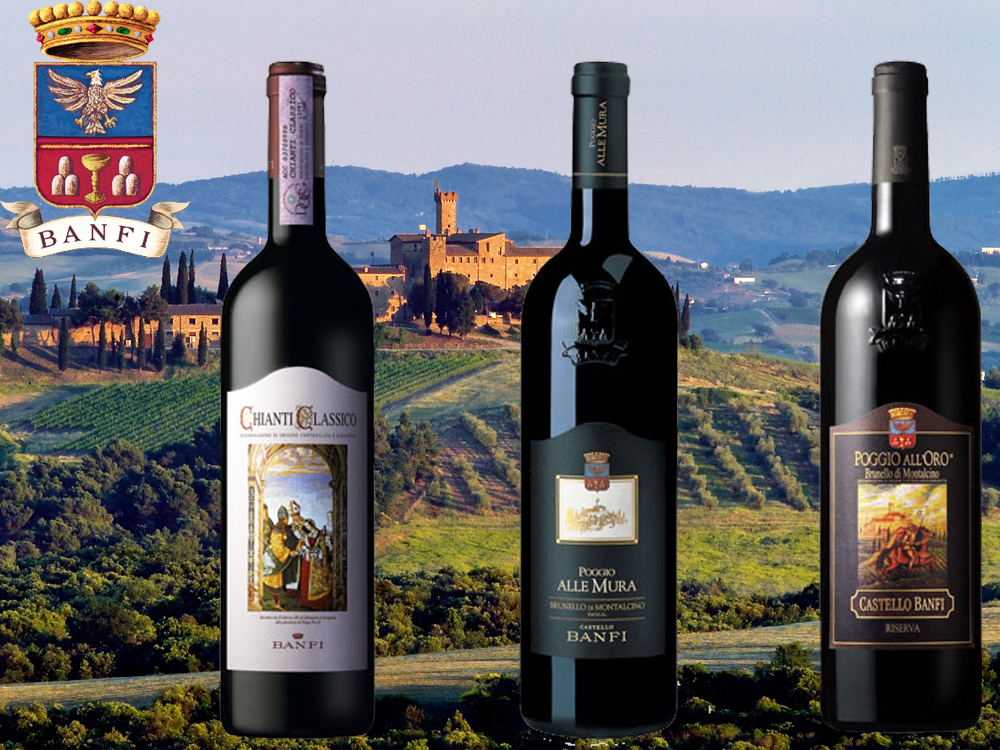
Recommendations for Celebrating
Sangiovese
BelnerO Proprietor’s Reserve Sangiovese
– A refined
cuvée of noble red grapes perfected by our pioneering
clonal research. This dark beauty, BelnerO, is
produced at our innovative winery, chosen 11
consecutive years as Italy’s Premier Vineyard Estate.
Fermented in our patented temperature controlled
French oak and aged approximately 2 additional years.
Unfiltered, and Nitrogen bottled to minimize sulfites.
Castello Banfi Brunello di Montalcino –
Rich, round, velvety and intensely
aromatic, with flavor hints of licorice, cherry, and
spices. Brunello di Montalcino possesses an intense
ruby-red color, and a depth, complexity and opulence
that is softened by an elegant, lingering aftertaste.
Unfiltered after 1998 vintage.
Castello Banfi Rosso di Montalcino – Brunello's "younger brother," produced
from select Sangiovese grapes and aged in barrique for
10 to 12 months. Deep ruby-red, elegant, vibrant,
well-balanced and stylish with a dry velvety
finish.
Poggio all’Oro Brunello di Montalcino
Riserva – A single vineyard selection of our most
historically outstanding Sangiovese, aged five years
before release, the additional year more than that
required of Brunello including 6 months in barrel and
6 months more in bottle to grant its “Riserva”
designation. Incredible
elegance and harmony. Intense with lots of fruit and
subtle wood influence. Round, complete, well balanced
with hints of chocolate and berries. Unfiltered after
1998.
Poggio alle Mura – The first tangible result of years of
intensive clonal research on Montalcino’s native
Sangiovese grape.
Estate bottled from the splendidly sun drenched
vineyards surrounding the medieval Castello from which
it takes its name.
The Brunello
di Montalcino is seductive, silky and smoky. Deep ruby
in color with an expressive bouquet of violets, fruits
and berries as well as cigar box, cedar and exotic
spices. The Rosso
di Montalcino is also intense ruby red. The bouquet
is fresh and fruity with typical varietal notes of
cherry and blackberry, enriched by more complex hints
of licorice, tobacco and hazelnut. It is full
bodied, yet with a soft structure, and a surprisingly
long finish. The Poggio alle Mura Brunello di Montalcino
Riserva is deep ruby red with garnet
reflections and a rich, ample bouquet that hints of
prune jam, coffee, cacao and a light balsamic note. It is full
and powerful, with ripe and gentle tannins that make
it velvety and harmonious; this wine is supported by a
pleasing minerality that to me speaks soundly of that
special hillside in southern Montalcino.
SummuS – A wine of towering elegance, SummuS is an
extraordinary blend of Sangiovese which contributes
body; Cabernet Sauvignon for fruit and structure; and
Syrah for elegance, character and a fruity bouquet. An elegant,
complex and harmonious red wine.
Cum Laude – A complex and elegant red which graduated
“With Honors,” characterized by aromas of juicy
berries and fresh spices.
Centine – A Cuvee that is more than half
Sangiovese, the balanced consisting of equal parts of
Cabernet Sauvignon and Merlot. Vinified in
a firm, round style that easily accompanies a wide
range of dishes, this is a smooth and fragrantly
satisfying wine with international character, and a
perennial favorite at my own dinner table.
Banfi Chianti Superiore – The “Superiore” designation signifies
stricter government regulations regarding production
and aging requirements, as compared to regular
Chianti. An
intense ruby red wine with fruit forward aromas and
floral notes. This
is a round wine with well-balanced acidity and fruit.
Banfi Chianti Classico – An enduring classic: alluring
bouquet of black fruit and violets; rich flavors of
cherry and leather; supple tannins and good acidity
for dining.
Banfi Chianti Classico Riserva – Produced from select grapes grown in the
"Classico" region of Chianti, this dry, fruity and
well-balanced red has a full bouquet reminiscent of
violets.
Fonte alla Selva Chianti Classico – This is our newest entry into the Chianti
arena, coming from a 99 acre estate in Castellina, the
heart of the Chianti Classico region. The wine is
a captivating mauve red that smells of cherry, plum
and blackberry with hints of spice. It is
round, full and balanced with very good
acidity.
Col di Sasso – Sangiovese and Cabernet Sauvignon. Luscious,
complex and soft with persistent notes of fruit and
great Italian style structure.
Any of John Mariani's books below may be ordered from amazon.com.
 The Hound in Heaven
(21st Century Lion Books) is a novella, and
for anyone who loves dogs, Christmas, romance,
inspiration, even the supernatural, I hope you'll find
this to be a treasured favorite. The story
concerns how, after a New England teacher, his wife and
their two daughters adopt a stray puppy found in their
barn in northern Maine, their lives seem full of promise.
But when tragedy strikes, their wonderful dog Lazarus and
the spirit of Christmas are the only things that may bring
his master back from the edge of despair.
The Hound in Heaven
(21st Century Lion Books) is a novella, and
for anyone who loves dogs, Christmas, romance,
inspiration, even the supernatural, I hope you'll find
this to be a treasured favorite. The story
concerns how, after a New England teacher, his wife and
their two daughters adopt a stray puppy found in their
barn in northern Maine, their lives seem full of promise.
But when tragedy strikes, their wonderful dog Lazarus and
the spirit of Christmas are the only things that may bring
his master back from the edge of despair. WATCH THE VIDEO!
“What a huge surprise turn this story took! I was completely stunned! I truly enjoyed this book and its message.” – Actress Ali MacGraw
“He had me at Page One. The amount of heart, human insight, soul searching, and deft literary strength that John Mariani pours into this airtight novella is vertigo-inducing. Perhaps ‘wow’ would be the best comment.” – James Dalessandro, author of Bohemian Heart and 1906.
“John Mariani’s Hound in Heaven starts with a well-painted portrayal of an American family, along with the requisite dog. A surprise event flips the action of the novel and captures us for a voyage leading to a hopeful and heart-warming message. A page turning, one sitting read, it’s the perfect antidote for the winter and promotion of holiday celebration.” – Ann Pearlman, author of The Christmas Cookie Club and A Gift for my Sister.
“John Mariani’s concise, achingly beautiful novella pulls a literary rabbit out of a hat – a mash-up of the cosmic and the intimate, the tragic and the heart-warming – a Christmas tale for all ages, and all faiths. Read it to your children, read it to yourself… but read it. Early and often. Highly recommended.” – Jay Bonansinga, New York Times bestselling author of Pinkerton’s War, The Sinking of The Eastland, and The Walking Dead: The Road To Woodbury.
“Amazing things happen when you open your heart to an animal. The Hound in Heaven delivers a powerful story of healing that is forged in the spiritual relationship between a man and his best friend. The book brings a message of hope that can enrich our images of family, love, and loss.” – Dr. Barbara Royal, author of The Royal Treatment.
 |
The Encyclopedia of American Food and Drink by John F. Mariani (Bloomsbury USA, $35) Modesty forbids me to praise my own new book, but let me proudly say that it is an extensive revision of the 4th edition that appeared more than a decade ago, before locavores, molecular cuisine, modernist cuisine, the Food Network and so much more, now included. Word origins have been completely updated, as have per capita consumption and production stats. Most important, for the first time since publication in the 1980s, the book includes more than 100 biographies of Americans who have changed the way we cook, eat and drink -- from Fannie Farmer and Julia Child to Robert Mondavi and Thomas Keller. "This book is amazing! It has entries for everything from `abalone' to `zwieback,' plus more than 500 recipes for classic American dishes and drinks."--Devra First, The Boston Globe. "Much needed in any kitchen library."--Bon Appetit. |
"Eating Italian will never be the same after reading John Mariani's entertaining and savory gastronomical history of the cuisine of Italy and how it won over appetites worldwide. . . . This book is such a tasteful narrative that it will literally make you hungry for Italian food and arouse your appetite for gastronomical history."--Don Oldenburg, USA Today. "Italian
restaurants--some good, some glitzy--far
outnumber their French rivals. Many of
these establishments are zestfully described
in How Italian Food Conquered the World, an
entertaining and fact-filled chronicle by
food-and-wine correspondent John F.
Mariani."--Aram Bakshian Jr., Wall Street
Journal.
"Equal parts
history, sociology, gastronomy, and just
plain fun, How Italian Food Conquered the
World tells the captivating and delicious
story of the (let's face it) everybody's
favorite cuisine with clarity, verve and
more than one surprise."--Colman Andrews,
editorial director of The Daily
Meal.com. "A fantastic and fascinating
read, covering everything from the influence
of Venice's spice trade to the impact of
Italian immigrants in America and the
evolution of alta cucina. This book will
serve as a terrific resource to anyone
interested in the real story of Italian
food."--Mary Ann Esposito, host of PBS-TV's
Ciao
Italia. "John Mariani has written the
definitive history of how Italians won their
way into our hearts, minds, and
stomachs. It's a story of pleasure over
pomp and taste over technique."--Danny Meyer,
owner of NYC restaurants Union Square
Cafe, The Modern, and Maialino.
|
 |
 |
 |
 |
 |
 |
 |
 |
 Everett Potter's Travel Report:
Everett Potter's Travel Report: 
 Eating Las Vegas
JOHN CURTAS has been covering the Las Vegas
food and restaurant scene since 1995. He is
the co-author of EATING LAS VEGAS – The 50
Essential Restaurants (as well as
the author of the Eating Las Vegas web site: www.eatinglasvegas.
He can also be seen every Friday morning as
the “resident foodie” for Wake Up With the
Wagners on KSNV TV (NBC) Channel 3 in
Las Vegas.
Eating Las Vegas
JOHN CURTAS has been covering the Las Vegas
food and restaurant scene since 1995. He is
the co-author of EATING LAS VEGAS – The 50
Essential Restaurants (as well as
the author of the Eating Las Vegas web site: www.eatinglasvegas.
He can also be seen every Friday morning as
the “resident foodie” for Wake Up With the
Wagners on KSNV TV (NBC) Channel 3 in
Las Vegas.
MARIANI'S VIRTUAL GOURMET
NEWSLETTER is published weekly. Publisher: John Mariani. Editor: Walter Bagley. Contributing Writers: Christopher Mariani,
Robert Mariani, Misha Mariani, John A. Curtas, Gerry Dawes, Geoff Kalish,
and Brian Freedman. Contributing
Photographer: Galina Dargery. Technical
Advisor: Gerry
McLoughlin.
If you wish to subscribe to this
newsletter, please click here: http://www.johnmariani.com/subscribe/index.html
© copyright John Mariani 2017

